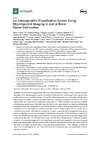Please use this identifier to cite or link to this item:
https://accedacris.ulpgc.es/jspui/handle/10553/41833
| Title: | An intraoperative visualization system using hyperspectral imaging to aid in brain tumor delineation | Authors: | Fabelo, Himar Ortega, Samuel Lazcano, Raquel Madroñal, Daniel Callicó, Gustavo M. Juárez, Eduardo Salvador, Rubén Bulters, Diederik Bulstrode, Harry Szolna, Adam Piñeiro, Juan F. Sosa, Coralia O'Shanahan, Aruma J. Bisshopp, Sara Hernández, María Morera, Jesús Ravi, Daniele Kiran, B. Ravi Vega Martínez, Aurelio Baez Quevedo, Abelardo Yang, Guang-Zhong Stanciulescu, Bogdan Sarmiento, Roberto |
UNESCO Clasification: | 220921 Espectroscopia 3314 Tecnología médica |
Keywords: | Hyperspectral imaging instrumentation Brain cancer detection Image processing |
Issue Date: | 2018 | Journal: | Sensors | Abstract: | Hyperspectral imaging (HSI) allows for the acquisition of large numbers of spectral bands throughout the electromagnetic spectrum (within and beyond the visual range) with respect to the surface of scenes captured by sensors. Using this information and a set of complex classification algorithms, it is possible to determine which material or substance is located in each pixel. The work presented in this paper aims to exploit the characteristics of HSI to develop a demonstrator capable of delineating tumor tissue from brain tissue during neurosurgical operations. Improved delineation of tumor boundaries is expected to improve the results of surgery. The developed demonstrator is composed of two hyperspectral cameras covering a spectral range of 400-1700 nm. Furthermore, a hardware accelerator connected to a control unit is used to speed up the hyperspectral brain cancer detection algorithm to achieve processing during the time of surgery. A labeled dataset comprised of more than 300,000 spectral signatures is used as the training dataset for the supervised stage of the classification algorithm. In this preliminary study, thematic maps obtained from a validation database of seven hyperspectral images of in vivo brain tissue captured and processed during neurosurgical operations demonstrate that the system is able to discriminate between normal and tumor tissue in the brain. The results can be provided during the surgical procedure (similar to 1 min), making it a practical system for neurosurgeons to use in the near future to improve excision and potentially improve patient outcomes. | URI: | https://accedacris.ulpgc.es/handle/10553/41833 | ISSN: | 1424-8220 | DOI: | 10.3390/s18020430 | Source: | Sensors (Switzerland)[ISSN 1424-8220],v. 18 (430) |
| Appears in Collections: | Artículos |
SCOPUSTM
Citations
126
checked on Jun 8, 2025
WEB OF SCIENCETM
Citations
92
checked on Jun 8, 2025
Page view(s)
59
checked on Sep 16, 2023
Download(s)
90
checked on Sep 16, 2023
Google ScholarTM
Check
Altmetric
Share
Export metadata
Items in accedaCRIS are protected by copyright, with all rights reserved, unless otherwise indicated.
